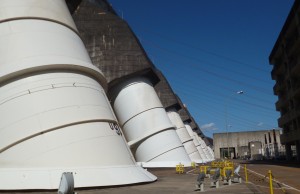Types of hydroelectricity
Waterwheels have been using the energy of water to power machinery for centuries. Now we can use the same idea to generate small amounts of electricity from rivers, streams or waterfalls. Hydroelectric dams can also be built to generate electricity in larger amounts.
How does it work?

Each of these huge pipes carries 700 cubic meters of water every second to turbines which spin and generate electricity
In hydroelectric dams, water is stored in reservoirs behind the dam and when electricity is needed, gates in the dam open to let water through. The water then spins the blades of big turbines as it rushes past which generate electricity using generators. Water pressure increases with height so if the water has started at a higher level when the gates are opened, the greater the power produced from the same amount of water. Smaller water wheels can also power generators when they turn as water from streams or waterfalls flow past.
Cost and efficiency
Hydroelectric dams are 95% efficient at making electricity as you do not lose any of the potential energy to heat. However, dams are very expensive to build. The Three Gorges Dam in China reportedly cost £16 billion!
Typical Size
Hydroelectric dams are huge. The Three Gorges Dam in China is 2335 metres long, 185 metres high and 115 metres wide at the bottom.
Locations around the world
Dams need to be built in valleys that have suitable geology to hold a large amount of water in the reservoir behind the wall. Some examples:
- Three Gorges Dam – China
- Itaipu Dam – Brazil/Paraguay
- Hoover Dam – USA
- Akosombo Dam – Ghana
Once they are built, hydroelectric dams are reliable and do not use much energy. They can also create more energy when lots of energy is needed at peak times because they can easily be turned on and off when necessary.
Bad news
There is an impact on humans and the environment if a dam is not designed correctly. It’s also hard to find suitable sites and very expensive to build.
Energy storage
The water that provides the potential energy to drive the turbines is stored in reservoirs behind the dam, ready to use when more energy is needed. Some hydroelectric power stations reuse the same water by pumping it back up again into the reservoir. This uses electricity so it is often done at off-peak times when there is surplus electricity.
Environmental impact
Small-scale waterwheels do not affect the environment too much. However, there are larger environmental changes if you build a hydroelectric dam. Because you are blocking a river and controlling the flow of it, water builds up behind the dam and creates a reservoir. The land will be covered with water causing loss of habitat. The dam will also stop fish swimming up or down the river unless special “fish ladders” are built.
When the Akosombo Dam in Ghana was built on the Volta River, much of the fertile land was flooded with water so villagers could not grow as much food, and the nutrients in the water did not flow to the parts of the river after the dam either so the fertile soils there decreased. There is also some evidence in Ghana that the rocks around the lake are not strong enough to hold all the water and this is causing small earthquakes.
Human impact
Often, whole towns or villages have to move because their land will become flooded with water if a dam is built. This disrupts communities who have been living in these places for centuries. When the Akosombo Dam was built in Ghana, the cattle manure and sewage that usually got washed into the river could not get any further than the dam so the water in the lake gained more nutrients and more weeds grew. These weeds are the perfect home for mosquitoes and snails that cause diseases like malaria and bilharzia which infect the humans living around the lake.
Is it a viable power source for the UK?
Many places suitable for hydroelectric dams have already been used so we cannot really increase the use of hydroelectricity very easily. Sites are limited for new dams to be built in the UK but several gigawatts are available. Hydroelectricity will probably not generate enough to provide us with the energy we want but it could make a contribution.
Current research
Scientists and engineers are currently working on investigating new sites for possible hydroelectric dams and also studying the impact of building them on the local area.


